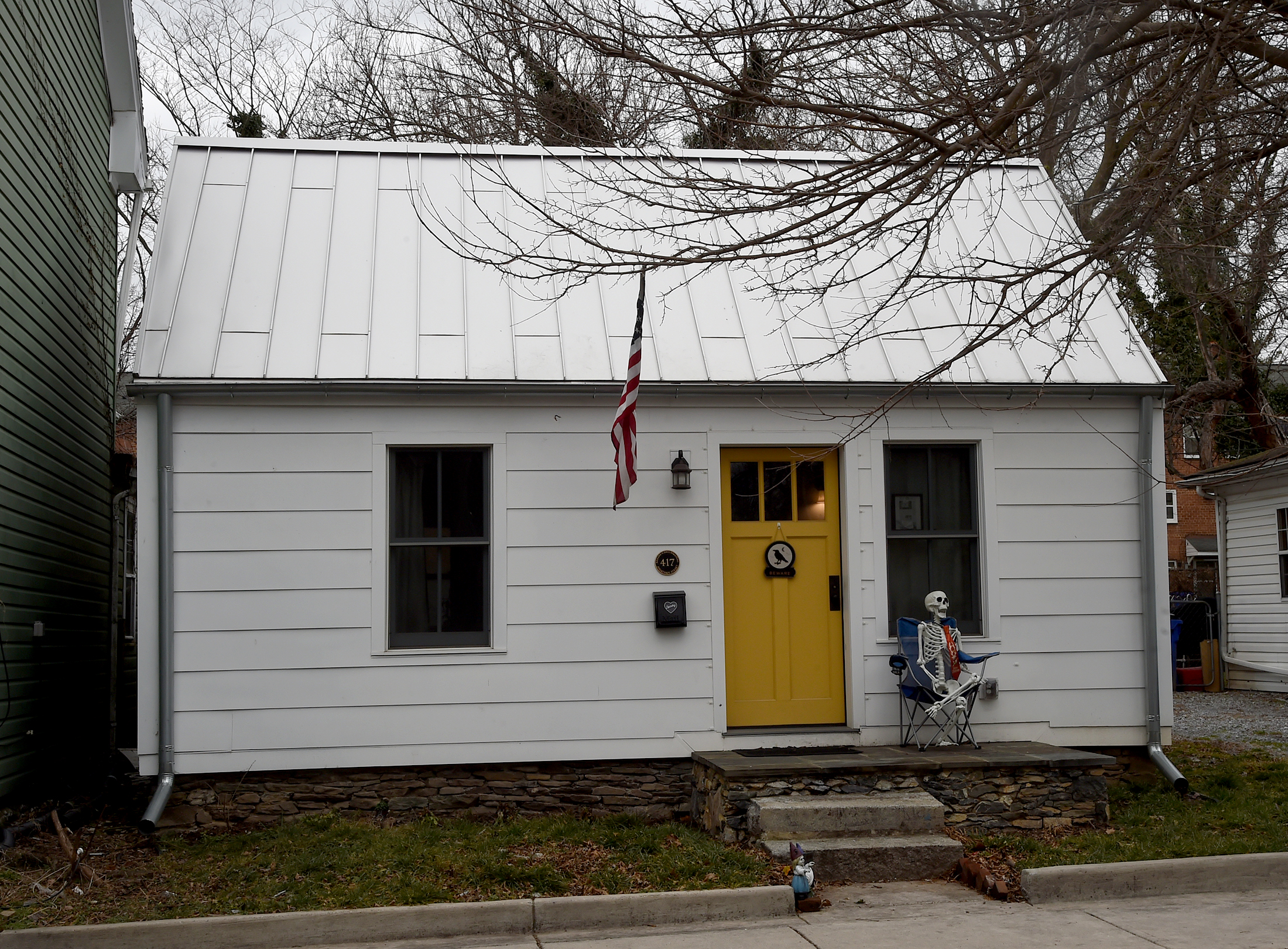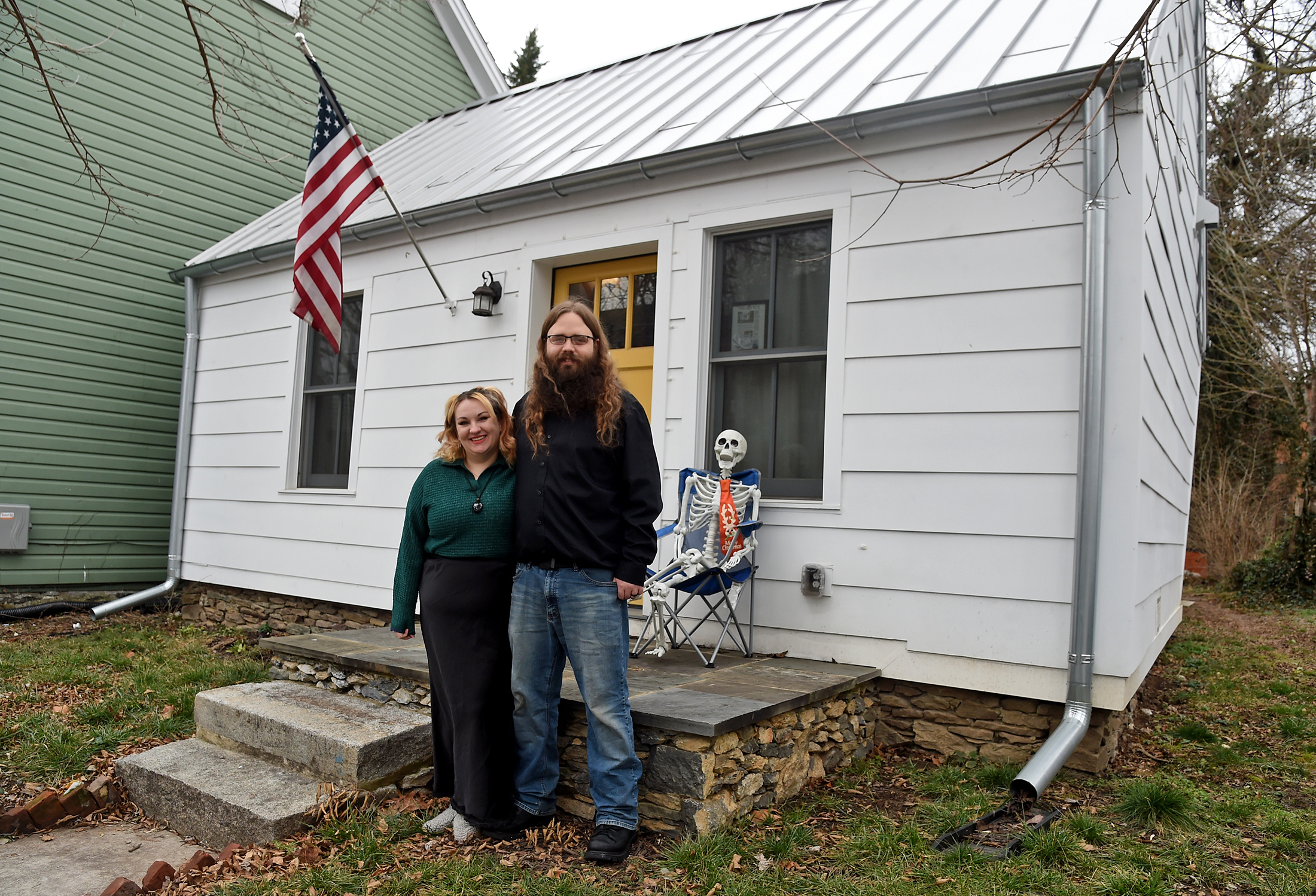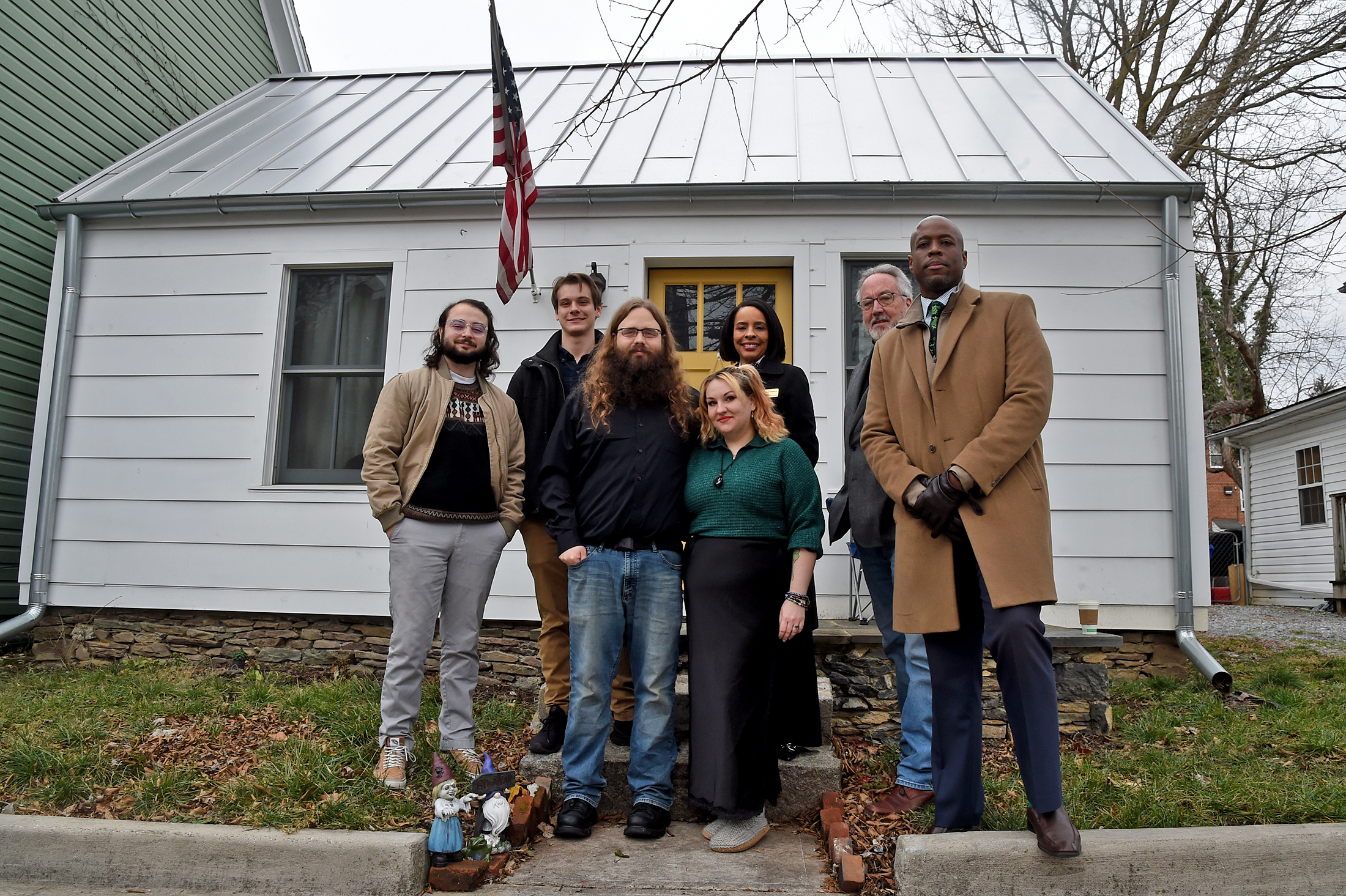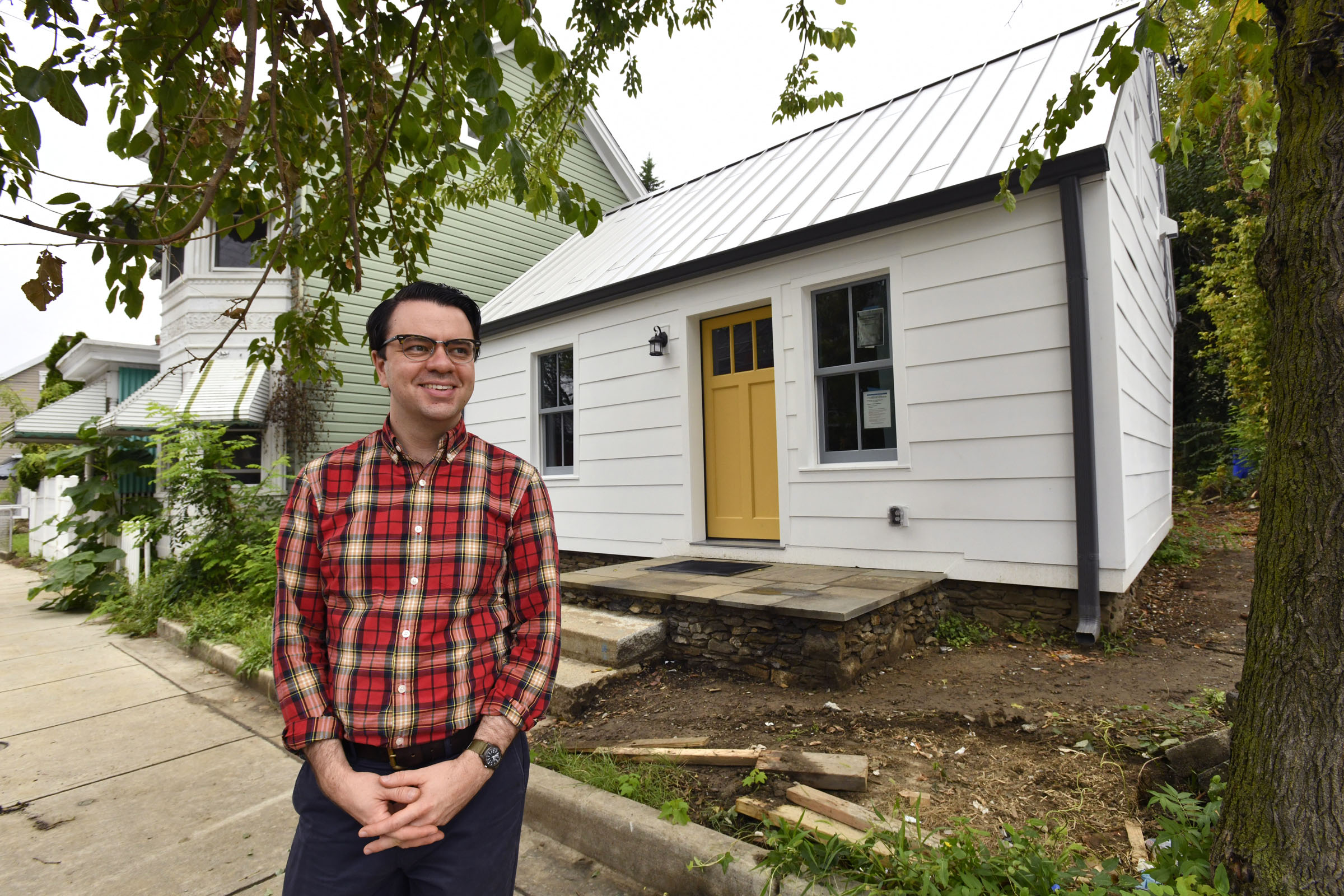Standing at 417 Jonathan St. is a small gem of a home, originally constructed with logs from trees felled decades before the U.S. became a country.
Today, the 466-square-foot house — not too long ago condemned before being researched and revitalized — is a window into Hagerstown’s past.
“Hagerstown has an incredible history, and this cabin was witness to all of it,” said Russ Hodge, a Frederick resident who is president of the video production company 3 Roads Communications.
It’s a tale he saw fit for the screen.
Starting Saturday, “The House on Jonathan Street,” a documentary Hodge executive produced, will air around the country on more than 300 PBS stations, and nationally on the PBS World channel Feb. 14.
Four years in the making, the documentary navigates slavery and segregation, Jonathan Street’s Black middle-class residents after the Civil War, redlining, and the effects of the opioid epidemic, with insight from politicians including Gov. Wes Moore.
The house was a catalyst for a broad historical excavation, Hodge said, connecting Hagerstown with trends and events of national significance.
“We cover 300 years of history in less than 60 minutes,” he said of the documentary. “The history of Hagerstown is really the history of America.”
The idea for a documentary was sparked when Hodge, who formerly produced shows including “Fox News Sunday” and Comedy Central’s “Politically Incorrect,” stumbled on a news story about the historic 1830s house, which a police officer had crashed his cruiser into in 2018. The home was condemned and the longtime owner, Richard Davis, moved elsewhere. Demolition, once imminent, was halted.
Hodge, 62, shared the article he read with his son, Patrick Hodge, and posed a question: “Am I crazy, or is there a story here?”
When Hodge drove into Hagerstown in 2020, he started making plans to film an archaeological dig at the site being led by the Maryland Department of Transportation State Highway Administration in partnership with Preservation Maryland, which bought the home from Davis earlier that year.
“If the timing wasn’t perfect, we wouldn’t have got this project done,” said Tereance Moore, a consultant. “With everything happening with George Floyd, as pressing as that was and as traumatic as that was, you wanted to hear something positive come out of our communities as well.”
Moore and Reggie Turner, a financial adviser and commissioner on the Maryland Commission on African American History and Culture, had joined Preservation Maryland to keep tabs on the loss of historic homes in the neighborhood, said Nicholas Redding, the nonprofit’s president and CEO.
Through dendrochronology, the science of dating tree rings, it was determined that logs used to build the cabin at 417 Jonathan St. were chopped down as early as the winter of 1739, Redding said, and put to use elsewhere before the Jonathan Street home was constructed. He added that the home was owned for a period by Elizabeth Hager, a descendant of the town’s founder, Jonathan Hager.
“It is potentially one of the oldest standing structures not only in Hagerstown, but probably in Washington County and perhaps even a fair bit of that part of the state,” Redding said.
Preservation Maryland raised several hundred thousand dollars to renovate the home, in an effort to keep it “a living, breathing part of that community,” Redding said.
The Jonathan Street neighborhood has long struggled with “disinvestment,” Hodge said. The documentary details how after a period of significant population growth and industrial success in Hagerstown beginning around 1880, “Jonathan Street had become the most notorious street in the rapidly declining city” that was hemorrhaging jobs. By the 1980s, “Downtown Hagerstown became a ghost town.”
But in its heyday, Jonathan Street was “very, very prosperous, for a very long time,” Hodge said.
Despite an absence of formal laws preventing Black residents or visitors from staying in town past sunset, Hagerstown effectively operated that way, the documentary explains — so Black residents made Jonathan Street their own, Hodge said.
“Jonathan Street was the Black Wall Street of Maryland,” Turner says in the documentary.
Created between 2020 and 2023, “The House on Jonathan Street” is narrated by the CEO of 3 Roads Communications and Hodge’s wife, Cynthia Scott. It features interviews with Hagerstown’s mayor, Tekesha Martinez; U.S. Senator Chris Van Hollen; authors and others who address everything from the discriminatory execution of GI Bill benefits after World War 2 to the birth of a concert venue for “top African American artists of the day.”
“The interviews really were the backbone for the entire documentary,” said Josh Cochran, who worked as a videographer and editor on the film with Patrick Hodge, who has participated in archaeological field schools in Maryland and in Ecuador.
“The history was fascinating, especially to hear from people that lived it.”
Cochran, who lives and grew up in Towson, worked with Hodge to conduct research and gather information at historical societies and libraries, including the Enoch Pratt Free Library in Baltimore. They also turned to the Baltimore newspaper The Afro.
The goal was to show how the Jonathan Street neighborhood has “fallen on hard times” but can still make a “comeback” if its history is revisited, said Cochran, 27. “When you know your history and where you came from, it might be easier to see a positive future.”
The history of Jonathan Street and the cabin wasn’t previously so widely known, said Patrick Hodge, 27, recounting one time when he captured the attention of a room of people by talking about his work on the documentary while getting his hair cut in Frederick.
The new owners of 417 Jonathan St. are also sharing the house’s story.
“Getting here and feeling the energy of the house, I just fell in love with it,” said Katrina Simpkins, 32, who moved in with her husband, James Smith, over a year ago.
“I’ve never really been in an area where there was a very tight-knit community,” said Smith, 34. He grew up in Chambersburg, Pennsylvania, and works as a machinist; Simpkins, who grew up in Clear Spring, is studying animal health and behavior online via Unity Environmental University.
Simpkins said the pair have felt welcomed by their new neighbors, though she initially feared their move as a white couple into the neighborhood being taken as a sign of gentrification.
“I’m … here because I understand the history and I can appreciate it, even if it’s not directly related to me,” Simpkins said. “I want to help preserve that for future generations.”
Preservation Maryland sold the home to the couple for $99,500, what Simpkins called an “incredible deal.” The nonprofit’s intent was to keep the price in line with the market and to avoid displacing existing residents; Redding said Preservation Maryland invested in the community.
The documentary, Cochran said, is also for those whose history it tells.
“The primary audience, for me, has always been the residents of Jonathan Street,” he said. “So I hope that they feel that we did their story justice.”
How to watch
“The House on Jonathan Street” will air on more than 300 PBS stations beginning Feb. 3. In Washington D.C., it will air on Howard University’s WHUT-TV Sunday at 1 p.m. and Monday at 5 p.m., followed by a screening event at the Martin Luther King Jr. Memorial Library on Feb. 8.
A Hagerstown screening at The Maryland Theatre is scheduled for the afternoon of Feb. 18.
The documentary will also air on WETA on Feb. 14 at 4 p.m. Maryland Public Television (MPT) is scheduled to air it on March 25 at 9 p.m.




